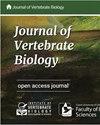Cedar plantations as habitat for Japanese squirrels in the cool temperate zone
IF 1.5
4区 生物学
Q2 ZOOLOGY
引用次数: 0
Abstract
Abstract. In this study, we determine whether coniferous plantations in the cool temperate zone of northeast Japan, with few natural evergreen forests, can serve as a habitat for Japanese squirrels. We also examine whether Japanese squirrel habitat use in cedar plantations varies based on forest structure. Our results showed that the relative frequency of squirrel occurrence, determined by camera traps and the number of feeding signs, was significantly higher at cedar forest survey sites than other forest types. The best generalised linear model for frequency of occurrence included the number of standing trees, canopy openness and understory visibility, while the best model for the number of feeding signs included total basal area, canopy openness and the number of walnut trees. The results suggest that cedar plantations within the study area serve partially as a habitat for squirrels, replacing natural evergreen trees. Furthermore, squirrel habitat use differed between cedar plantations based on forest structure, confirming the importance of a diverse forest structure for squirrels. Therefore, when considering the conservation and management of small arboreal mammals that use such plantations, they must include diverse structures to facilitate their use as a habitat.雪松种植园是日本松鼠在冷温带的栖息地
摘要在本研究中,我们确定了日本东北部寒温带的针叶人工林是否可以作为日本松鼠的栖息地,因为天然常绿森林很少。我们还研究了杉木人工林中松鼠栖息地的利用是否因森林结构而异。结果表明,在杉木林调查点,松鼠的相对出现频率(通过相机陷阱和摄食标志的数量来确定)显著高于其他森林类型。常立树数、冠层开度和林下能见度是采食标志的最佳广义线性模型,总基面积、冠层开度和核桃树数是采食标志的最佳广义线性模型。研究结果表明,研究区内的雪松人工林部分取代了天然常绿树木,成为松鼠的栖息地。此外,基于森林结构的不同,杉木人工林对松鼠栖息地的利用也不同,这证实了森林结构多样化对松鼠的重要性。因此,在考虑使用这些人工林的小型树栖哺乳动物的保护和管理时,必须包括多样化的结构,以促进其作为栖息地的使用。
本文章由计算机程序翻译,如有差异,请以英文原文为准。
求助全文
约1分钟内获得全文
求助全文

 求助内容:
求助内容: 应助结果提醒方式:
应助结果提醒方式:


